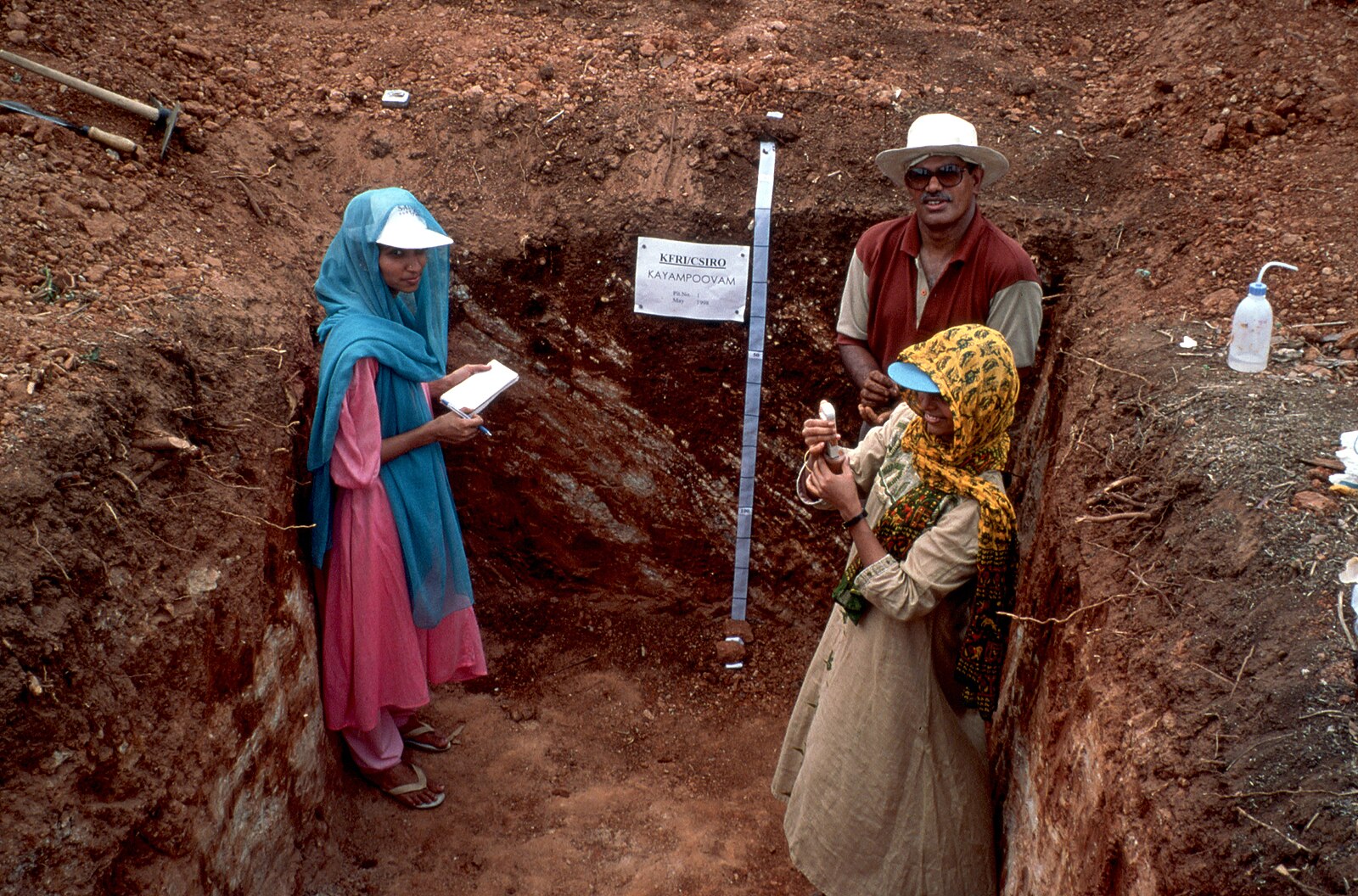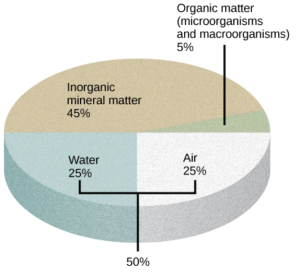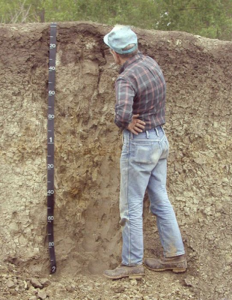5.7 Career Connection: Soil Scientist
Hannah Nelson and Christelle Sabatier
 Figure 5.7.1. Describing soil profiles on one of the Commonwealth Scientific and Industrial Research Organization (CSIRO) experimental sites, Kerala State, India. [Image description]
Figure 5.7.1. Describing soil profiles on one of the Commonwealth Scientific and Industrial Research Organization (CSIRO) experimental sites, Kerala State, India. [Image description]
Plants obtain inorganic elements from the soil, which serves as a natural medium for land plants. Soil is the outer loose layer that covers the surface of Earth. Soil quality is a major determinant, along with climate, of plant distribution and growth. Soil quality depends not only on the chemical composition of the soil, but also the topography (regional surface features) and the presence of living organisms. In agriculture, the history of the soil, such as the cultivating practices and previous crops, modify the characteristics and fertility of that soil.
Soil develops very slowly over long periods of time, and its formation results from natural and environmental forces acting on mineral, rock, and organic compounds. Soils can be divided into two groups: organic soils are those that are formed from sedimentation and primarily composed of organic matter, while those that are formed from the weathering of rocks and are primarily composed of inorganic material are called mineral soils. Mineral soils are predominant in terrestrial ecosystems, where soils may be covered by water for part of the year or exposed to the atmosphere.
Soil Composition
A typical soil consists of the following major components (Figure 5.19):
- Inorganic mineral matter, about 40% to 45% of the soil volume
- Organic matter, about 5% of the soil volume
- Water and air, about 50% of the soil volume
The amount of each of the four major components of soil depends on the amount of vegetation, soil compaction, and water present in the soil. A good healthy soil has sufficient air, water, minerals, and organic material to promote and sustain plant life.

Soil Scientist

A soil scientist studies the biological components, physical and chemical properties, distribution, formation, and morphology of soils. Soil scientists need to have a strong background in physical and life sciences, plus a foundation in mathematics. They may work for federal or state agencies, academia, or the private sector. Their work may involve collecting data, carrying out research, interpreting results, inspecting soils, conducting soil surveys, and recommending soil management programs.
Many soil scientists work both in an office and in the field. A soil scientist studies the physical, chemical, and biological properties of soil to classify, map, and manage land for various uses including agriculture, environmental conservation and construction. Their work involves fieldwork for collecting samples and office-based analysis to interpret data and write reports, offering practical guidance on land use and sustainability for farmers, environmental agencies, and the public. You can learn more about soil scientists in the video below:
Video 5.7.1 Occupational Video – Soil Scientist. ALIS website
Soil scientists play a key role in understanding the soil’s past, analyzing present conditions, and making recommendations for future soil-related practices.

Dr. Alfredo Alvarado Hernández is a soil scientist currently working at the University of Costa Rica. As Dr. Hernández has expressed, “Costa Rica has extraordinary soil variability in a very limited area” due to the high variation of parent material available for soil formation.
Dr. Hernández’s areas of study and interests are just as diverse as the soil composition of Costa Rica. Most of his work has been directed towards soil-plant relationships, soil compaction on livestock-housing land, and soil nutrient retention. His most recently published work was in 2014 regarding Inceptisol (a widely distributed soil order) and its mineral content relative to parent material. The research that Dr. Hernández has performed directly supports a greater understanding of ecological change, and a path to more sustainable ways of living for farmers and builders.
To read more about Dr. Hernández’s research, read “Potential of Soil Carbon Sequestration in Costa Rica,” one of his many articles.
Figure Descriptions
Figure 5.7.1. The image depicts three individuals in an excavation site, standing in a rectangular trench with exposed earth walls. The trench has a vertical measurement tape and a sign affixed to the wall. The person on the left wears a pink dress and a blue scarf covering their head, holding a notepad and a pen. In the center right, another person in a hat and sunglasses, wearing a maroon vest, stands partially visible. To the right, a third person, wearing a long-sleeved beige dress with a patterned yellow and brown scarf covering their head, is holding a container. The ground is reddish-brown soil, suggesting an archaeological or geological study setting. Excavation tools and a plastic bottle are visible on the ground above the trench. [Return to Figure 5.7.1]
Figure 5.7.2. Pie chart showing soil is composed of 45% inorganic mineral matter, 25% water, 25% air, 5% organic matter (microorganisms and microorganisms); water and air shown as 50% pore space. [Return to Figure 5.7.2]
Figure 5.7.3. Scientist looking at a cut through soil, making observations. A long measuring stick stands next to him. [Return to Figure 5.7.3]
Figure 5.7.4. Close-up of Dr. Alfredo Alvarado Hernández wearing glasses, a white shirt and a dark brown sleeveless jacket. He is sitting in front of a bookcase filled with books. [Return to Figure 5.7.4]
Licenses and Attributions
“5.7 Career Connections: Soil Scientist” is adapted from “31.2 Soil” by Mary Ann Clark, Matthew Douglas, and Jung Choi for OpenStax Biology 2e under CC-BY 4.0. “5.7 Career Connections: Soil Scientist” is licensed under CC-BY-NC 4.0.
Media Attributions
- CSIRO_ScienceImage_712_Soil_Profiling_India © T.Grove, CSIRO is licensed under a CC BY (Attribution) license
- Private: 1A.B.soilpiechart
- Private: 1A.B.soilscientist
- 1A.B.Dr.Alverado-Hernandez
